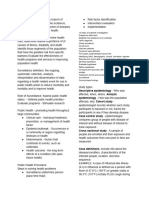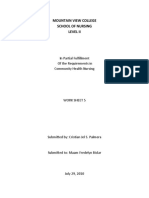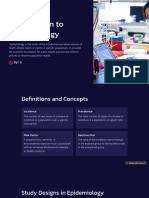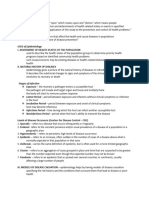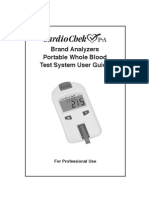Foundation 1.2
Foundation 1.2
Uploaded by
ANDRIANNE FAGUTAOCopyright:
Available Formats
Foundation 1.2
Foundation 1.2
Uploaded by
ANDRIANNE FAGUTAOOriginal Title
Copyright
Available Formats
Share this document
Did you find this document useful?
Is this content inappropriate?
Copyright:
Available Formats
Foundation 1.2
Foundation 1.2
Uploaded by
ANDRIANNE FAGUTAOCopyright:
Available Formats
FOUNDATIONS Nature of Epidemiologic
Approaches
2. Cohort studies
Epidemiology
* The goal of epidemiology is to study
the frequency of occurrence of health- – Population with known levels of
- The study of factors that affect the exposure to potential causative and
health and cause diseases in related events, majority to the causes
and determinants of disease patterns in protective factors is recruited and
populations. followed over time to determine who
populations.
gets and who does not get the disease
- The backbone of disease prevention. of interest.
Systemic investigation can identify
- The systematic study of the distribution causal (contributory) and preventive
factors – an observational science. - Relatively long term (5-20 years) -
patterns and determinants of health, More expensive.
diseases and conditions in a population
for the purpose of promoting wellness Does population exposure to X
increases the risk of disease Z? Patterns of Disease Occurrence
and preventing diseases or disease-
causing conditions. 1. Sporadic – intermittent occurrence or
Are dietary supplements (X, Y, Z)
beneficial in lowering the risk of on-and-off presence of disease.
*The objective is to provide effective
solutions for controlling diseases and disease?
2. Endemic – continuous or constant
preventive measures to populations that occurrence of a disease in certain area.
are at risk. Epidemiologic Classification
3. Epidemic – sudden increase in the
Epidemiology Descriptive – attempts to describe
number of cases in short period of time
patterns (tabulations or summaries of
in certain area.
Multiple Causation Theory: polls or surveys) of disease according to
spatial and temporal information about
4. Pandemic – worldwide epidemic or
the members of a population.
global outbreak.
Analytical – attempts to explain and Epidemiologic Process
predict the state of a population’s health.
The goal is to summarize the 1. Determine the nature, extent and
Web of Causation: relationship between exposure and scope of the problem.
disease incidence by comparing two
measures of disease frequency. a. Establishing the epidemic – present
prevalence of the disease and incidence
Descriptive vs Analytical of the disease
b. Appraisal of facts – involves
studying the characteristics of epidemic
Ecological Triad: in terms of the distribution patterns
involving: Person – demographic data,
Place, Time – onset of outbreak.
2. Formulate hypothesis – collect and
analyze data to test the hypothesis
3. Testing the hypothesis – conducting
a diagnostic exam to prove the source of
the disease.
4. Making conclusion and
recommendations – emphasizing the
significant results of investigation.
5. Plan for control of spread of the
disease by suggesting what can be done
to stop the epidemic.
6. Implement the control program
7. Evaluate the control program
8. Make appropriate report as basis for
diagnostic purposes, preventive or pre-
emptive actions to prevent the
Ecological Triad reoccurrence of the same disease or
Approaches to Epidemiology (use to
analyze and determine factors that condition and research activities.
affect rates of a particular disease)
Agriculture and Health
1. Case control studies
Population health is strongly
– Individuals with and without the influenced by society and environment.
disease of interest are recruited from the
same population, and their prior histories Agriculture is one of the social and
of exposure to potential causative and environmental determinants of health.
protective factors are compared.
Agriculture is essential for good health
- Relatively short term (2-5 years) - — it produces the world’s food, fibre,
Less expensive and materials for shelter, and can
produce medicinal
plants; it is also an important source of In the other direction, health affects years, meaning humans are said to have
livelihood for many of the poor in people’s abilities, needs and desires to a lifespan of 122 years.
developing countries. consume different amounts and types of
food, which in turn affects demand from People will have only one life span
Agriculture also can lead to poor agricultural systems and the types of while life expectancy changes as you
health – linked to the main causes of products. grow older, and as you face different
death and disease — malnutrition, risks.
infectious diseases and chronic
diseases. Many infants and young children in
Technology and Health America used to die due to infections.
Importance of examining agriculture - High infant and child mortality kept life
presents not only opportunities for Technological developments changes expectancy (which is usually expressed
improving health but also risks to health. healthcare dramatically. as life expectancy from birth) low until
well into the 20th century, but once
Bidirectional relationship: agriculture New drugs and treatments, new people passed those vulnerable early
influences health and health influences devices, new equipment and years, the life expectancy was much
agriculture. higher. For instance, the life expectancy
machine, new social media support for for a female born in 1900 was about 48
In agricultural communities, poor healthcare, and etc. years old, but if she reached age 20, her
health reduces income and productivity, life expectancy was over 60, and at age
further decreasing people’s ability to Technology automates and extends 40, her life expectancy was nearly 70.
address poor health and inhibiting things that previously had to be done by
economic development more broadly, people. We can calculate an average life span
while in the population at large, of people in a group if we have birth and
malnutrition and disease patterns Patients generate huge amounts of death dates for its members.
influence market demand for agricultural information – patient records– from X-
products. rays to blood test results. Replacing
paper with computerized summaries
Conceptual framework of the links make patient care easier and more
between agriculture and health efficient.
Links on agricultural producers Social media, patient power, mobile
health and education stopping people
Link is via income– farmers and going to hospital and empowering
workers earn income from agriculture people to care for themselves and their
ability to purchase and gain access to families.
food, water, land and health-related
services determines their overall Healthcare sensors can be readily
health status. bought off the internet, and it is easy for
technically-minded people today to build
Links is via labor – labor affects sophisticated equipment (to hack) to
energy expenditure and the time collect and analyses any personal or
available for child care and food clinical data using their own computers.
preparation. Farming exposes producers
to a range of occupational health Life Expectancy vs Life Span
hazards.
Life Expectancy
Links is via labour – amount and
type of agricultural employment refers to the number of years a person
migration and the search for alternative is expected to live, based on the
income sources the spread of and statistical average.
exposure to disease (e.g., HIV/AIDS)
statistical average is calculated based
Links is via access to health-related on a population overall, including those
services and food –malnutrition and who die shortly during childbirth, shortly
poor health affecting their capacity to after childbirth, during adolescence or
work and generate food and income adulthood, those who die in war and
malnutrition and poor health. those who live well into old age.
Links is via environmental change - Influenced by factors such as gender,
livestock production animals are race, exposure to pollution, education
associated with different zoonoses (e.g., status, race, income level and
working with dairy cows and sheep is a healthcare access.
risk factor for brucellosis). Health
agricultural systems – poor health Influenced also by modifiable lifestyle
reduces the ability of producers to factors such as exercise, alcohol status,
innovate, invest in and operationalize smoking status and diet.
changes in agricultural systems —
including changes that promote health. Therefore, life expectancy is highly
variable from one individual to another.
Major output — (unsafe) food
contaminated during agricultural Life Span
production — can carry foodborne
illnesses and affects nutrition. refers to the maximum number of
years that a person can potentially
Example: pathogens on raw fruits and expect to live based on the greatest
vegetables may be the result of irrigation number of years anyone from the same
with inadequately treated wastewater, data set has lived.
and aflatoxins may be present in staple
crops. Example: the oldest documented age
reached by any living individual is 122
You might also like
- Community-Acquired Pneumonia PathophysiologyDocument2 pagesCommunity-Acquired Pneumonia PathophysiologyFrancis Adrian86% (14)
- Epidemiology and The NurseDocument26 pagesEpidemiology and The NurseCris Melric Palanog100% (3)
- EpidemilogyDocument2 pagesEpidemilogyAhmed FathiNo ratings yet
- Activity 2 Study Guide Questions WEEK 6 CHN 2 FERRER JOHN DENVER A.Document7 pagesActivity 2 Study Guide Questions WEEK 6 CHN 2 FERRER JOHN DENVER A.Novelyn PuaNo ratings yet
- EPIDEMIOLOGYDocument4 pagesEPIDEMIOLOGYmblanco.dchNo ratings yet
- Invesiation of EpidemicDocument33 pagesInvesiation of EpidemicNagendrappa MalipatilNo ratings yet
- DD Cheat Sheet 21-22Document2 pagesDD Cheat Sheet 21-22loki anshNo ratings yet
- Epidemiological Research Methods D. NYING TDocument17 pagesEpidemiological Research Methods D. NYING TDEREK DARRELNo ratings yet
- (EPI) 1.01 - Overview of Epidemiology & Descriptive Epidemiology - Dr. ButacanDocument5 pages(EPI) 1.01 - Overview of Epidemiology & Descriptive Epidemiology - Dr. Butacanpasambalyrradjohndar0% (1)
- PCM TransDocument3 pagesPCM TranschayChay gapolNo ratings yet
- Brief History of EpidemiologyDocument9 pagesBrief History of EpidemiologyLuningning UmarNo ratings yet
- Lecture 4 & 5. Epidemiological StudiesDocument58 pagesLecture 4 & 5. Epidemiological StudiesHaneen Al-HajjNo ratings yet
- Chapter 101 EpidemiologyDocument44 pagesChapter 101 EpidemiologyYassir OunsaNo ratings yet
- Epidemiology BASICSDocument59 pagesEpidemiology BASICSankikumari10No ratings yet
- Epidemiology WholeDocument141 pagesEpidemiology WholeSonali SehrawatNo ratings yet
- EpidemiologyDocument67 pagesEpidemiologyChrystel Mae PañaresNo ratings yet
- By-Dr. Oinam Monica DeviDocument98 pagesBy-Dr. Oinam Monica DevimonikaNo ratings yet
- BiostatsDocument5 pagesBiostatsalvarez.sofiadennieceNo ratings yet
- Epidemiology 1Document2 pagesEpidemiology 1marco.aziz01No ratings yet
- 03-3 Epidemiology in Public HealthDocument75 pages03-3 Epidemiology in Public HealthAhmad SobihNo ratings yet
- 08 Introduction To Epidemiology and Descriptive Epidemiology AIADocument5 pages08 Introduction To Epidemiology and Descriptive Epidemiology AIAAia DollisonNo ratings yet
- Epidemiological Study DesignsDocument57 pagesEpidemiological Study DesignsADUGNA DEGEFENo ratings yet
- Advanced Veterinary EpidemiologyDocument103 pagesAdvanced Veterinary EpidemiologyDung NguyenNo ratings yet
- Bioe 211 - Outbreak InvestigationDocument4 pagesBioe 211 - Outbreak Investigationbabalegaspi09No ratings yet
- BIOE Week 14Document4 pagesBIOE Week 14FelicityNo ratings yet
- EpidemiologyDocument56 pagesEpidemiologySaira JabeenNo ratings yet
- Module 1Document4 pagesModule 1Mc Philip Gabay DamoclesNo ratings yet
- Public Health: Introduction To EpidemiologyDocument61 pagesPublic Health: Introduction To EpidemiologyMarchelleNo ratings yet
- Epidemiological Methodology & Medical StatisticsDocument10 pagesEpidemiological Methodology & Medical StatisticsDina Saad EskandereNo ratings yet
- MamuDocument4 pagesMamuTausique SheikhNo ratings yet
- AMA 4351 Statistical EpidemiologyDocument72 pagesAMA 4351 Statistical EpidemiologyRobinson WambuaNo ratings yet
- Module 1 - Research Methods - LauzardoDocument19 pagesModule 1 - Research Methods - LauzardoAbdi MohammedNo ratings yet
- Advance Epi & Direct Acyclic GraphDocument14 pagesAdvance Epi & Direct Acyclic GraphPurnima VermaNo ratings yet
- Definition and Aim of EpidemiologyDocument25 pagesDefinition and Aim of EpidemiologyJeevan KumarNo ratings yet
- Introduction To EpidemiologyDocument61 pagesIntroduction To Epidemiologycas'perNo ratings yet
- Epi FinalDocument481 pagesEpi FinalSana Savana Aman R100% (1)
- Introduction of Epidemiology and Public Health - (Roll No.02)Document6 pagesIntroduction of Epidemiology and Public Health - (Roll No.02)HeroNo ratings yet
- Disease Detectives Cheat Sheet PDFDocument2 pagesDisease Detectives Cheat Sheet PDFAnnabeth ChaseNo ratings yet
- Lecture 2-4Document95 pagesLecture 2-4Aiman AnsariNo ratings yet
- EpidemiologyDocument24 pagesEpidemiologyArcel SasaluyaNo ratings yet
- p02 Identifying Outbreak and Investigation Steps - 0Document28 pagesp02 Identifying Outbreak and Investigation Steps - 0budidivNo ratings yet
- Introduction To EpidemiologyDocument61 pagesIntroduction To EpidemiologyTHARSHINI MURUGAIAHNo ratings yet
- Epidemiology: Andre Bencee V. Barimbao, RMT, MLS (ASCP)Document55 pagesEpidemiology: Andre Bencee V. Barimbao, RMT, MLS (ASCP)Alondra Aran100% (2)
- Mountain View College School of Nursing Level Ii: in Partial Fulfillment of The Requirements in Community Health NursingDocument6 pagesMountain View College School of Nursing Level Ii: in Partial Fulfillment of The Requirements in Community Health NursingCrizina VashtiNo ratings yet
- Principles of Epidemilogy NSC 309Document30 pagesPrinciples of Epidemilogy NSC 309abdulfatimazaraNo ratings yet
- Week 15 Outbreak InvestigationDocument13 pagesWeek 15 Outbreak InvestigationAngeline LimNo ratings yet
- Safari - May 31, 2023 at 955 AMDocument1 pageSafari - May 31, 2023 at 955 AMmartinsoladapo19No ratings yet
- Epidemiology 2 PDFDocument11 pagesEpidemiology 2 PDFJawad TatlahNo ratings yet
- Epidemiology and Public Health in DermatologyDocument8 pagesEpidemiology and Public Health in DermatologydennisguasonNo ratings yet
- EpidemologyDocument22 pagesEpidemologyVivek MahaleNo ratings yet
- Epidemiology & EcologyDocument18 pagesEpidemiology & EcologyPrantor KarmakerNo ratings yet
- EpidemiologyDocument13 pagesEpidemiologyswethashaki67% (3)
- Epidemiology Lesson PlanDocument7 pagesEpidemiology Lesson PlanIshika RoyNo ratings yet
- Introduction To EpidemiologyDocument34 pagesIntroduction To Epidemiologyhamza khanNo ratings yet
- Investigation of An EpidemicDocument18 pagesInvestigation of An Epidemicm.msilasNo ratings yet
- Introduction To EpidemiologyDocument9 pagesIntroduction To EpidemiologyAakash SpNo ratings yet
- Occupational EpidimiologyDocument85 pagesOccupational EpidimiologyApril Joy MercadoNo ratings yet
- Epidemiology HandoutDocument4 pagesEpidemiology Handoutferrerjericho300No ratings yet
- 02.intro To Epidemiology. 26 SlidesDocument26 pages02.intro To Epidemiology. 26 SlidesUm e UsmanNo ratings yet
- Understanding Anal Fistulas: Comprehensive Insights into Etiology, Management, and Future PerspectivesFrom EverandUnderstanding Anal Fistulas: Comprehensive Insights into Etiology, Management, and Future PerspectivesNo ratings yet
- CPH Final ReviewersDocument10 pagesCPH Final ReviewersANDRIANNE FAGUTAONo ratings yet
- Foundation 1.1Document3 pagesFoundation 1.1ANDRIANNE FAGUTAONo ratings yet
- ANALYTICAL CHEMISTRY ReviwerDocument2 pagesANALYTICAL CHEMISTRY ReviwerANDRIANNE FAGUTAONo ratings yet
- STS CompilationDocument4 pagesSTS CompilationANDRIANNE FAGUTAONo ratings yet
- Pe Mid Exam 1.2Document4 pagesPe Mid Exam 1.2ANDRIANNE FAGUTAONo ratings yet
- STS 2ND Sem NotesDocument10 pagesSTS 2ND Sem NotesANDRIANNE FAGUTAONo ratings yet
- Rhythmic ActivitiesDocument1 pageRhythmic ActivitiesANDRIANNE FAGUTAONo ratings yet
- Pe Mid Exam 1.1Document3 pagesPe Mid Exam 1.1ANDRIANNE FAGUTAONo ratings yet
- Physiologically BasedDocument33 pagesPhysiologically BasedDrAmit VermaNo ratings yet
- CARDIOCHECKDocument40 pagesCARDIOCHECKAnbuselvam HaridassNo ratings yet
- Materi Safety InductionDocument26 pagesMateri Safety InductionGibran RamadhanNo ratings yet
- Belt Conveyor Idler: Read These Instructions Carefully Before Starting InstallationDocument8 pagesBelt Conveyor Idler: Read These Instructions Carefully Before Starting InstallationKenji LacambraNo ratings yet
- Kelompok KfaDocument16 pagesKelompok KfaMaulidya SilvianaNo ratings yet
- Introduction To Behavioral Science: Col Zulfiquer Ahmed Amin Armed Forces Medical Institute (AFMI)Document60 pagesIntroduction To Behavioral Science: Col Zulfiquer Ahmed Amin Armed Forces Medical Institute (AFMI)MishaNo ratings yet
- Pressure Ulcer Categorisation GuidanceDocument2 pagesPressure Ulcer Categorisation GuidanceJerome EstoresNo ratings yet
- The Promotion of Exclusive Breastfeeding inDocument7 pagesThe Promotion of Exclusive Breastfeeding inRebeca SáNo ratings yet
- The Role of HR in Employee Mental HealthDocument8 pagesThe Role of HR in Employee Mental Healthmarkus09.greenNo ratings yet
- Medical History Form 3 Years and OlderDocument3 pagesMedical History Form 3 Years and OlderJalisha SarmientoNo ratings yet
- Silence, Screams and Sex: Legality of Prostitution in IndiaDocument11 pagesSilence, Screams and Sex: Legality of Prostitution in IndiaArya SenapatiNo ratings yet
- 24th - EISIC - 2021 - Excellence - Services - Conference - Full ProgrammeDocument5 pages24th - EISIC - 2021 - Excellence - Services - Conference - Full ProgrammemariagianniNo ratings yet
- Dock Labour Regulations: - Who Made This RegulationDocument35 pagesDock Labour Regulations: - Who Made This RegulationAku RajNo ratings yet
- PHD Dissertation University of ChicagoDocument7 pagesPHD Dissertation University of ChicagoPaySomeoneToWriteAPaperForMeUK100% (1)
- Rethinking Sustainable Food Offering in PeruDocument17 pagesRethinking Sustainable Food Offering in PeruGreta Manrique GandolfoNo ratings yet
- Module 12-Private STPDocument89 pagesModule 12-Private STPPhel FloresNo ratings yet
- Psych Units 11-13 Cheat SheetDocument1 pagePsych Units 11-13 Cheat SheetTalia ShumanNo ratings yet
- Epidemio-Clinical Profile of Atopic Dermatitis in Children in General Population in Parakou (Benin)Document4 pagesEpidemio-Clinical Profile of Atopic Dermatitis in Children in General Population in Parakou (Benin)asclepiuspdfsNo ratings yet
- Overcoming Barriers To Using Telehealth For Standardized Language AssessmentsDocument11 pagesOvercoming Barriers To Using Telehealth For Standardized Language Assessments賴奕全No ratings yet
- Orca Share Media1666524188288 6989909069033530709Document4 pagesOrca Share Media1666524188288 6989909069033530709Sherylou Kumo SurioNo ratings yet
- Research Paper Draft 3Document9 pagesResearch Paper Draft 3api-355074620No ratings yet
- AmazingDocument18 pagesAmazingNazim DjedaaNo ratings yet
- Implementation Phase: Table 19. Nursing Care ImplementationDocument5 pagesImplementation Phase: Table 19. Nursing Care ImplementationJim RashidNo ratings yet
- Bgpms FormDocument10 pagesBgpms FormSaidamen R. Mambayao100% (1)
- Cataract SurgeryDocument4 pagesCataract SurgeryjuliaNo ratings yet
- Drill PressDocument1 pageDrill PressSivaneshen JeevakrishnanNo ratings yet
- Strength Coachs ManualDocument11 pagesStrength Coachs ManualFer Servin Silva0% (1)
- CLED AnswersDocument3 pagesCLED AnswersGaudencio DemaisipNo ratings yet
- Module 4 Lesson 12 Class Exercise Victoria NembawareDocument5 pagesModule 4 Lesson 12 Class Exercise Victoria Nembawarelucy kabazziNo ratings yet






